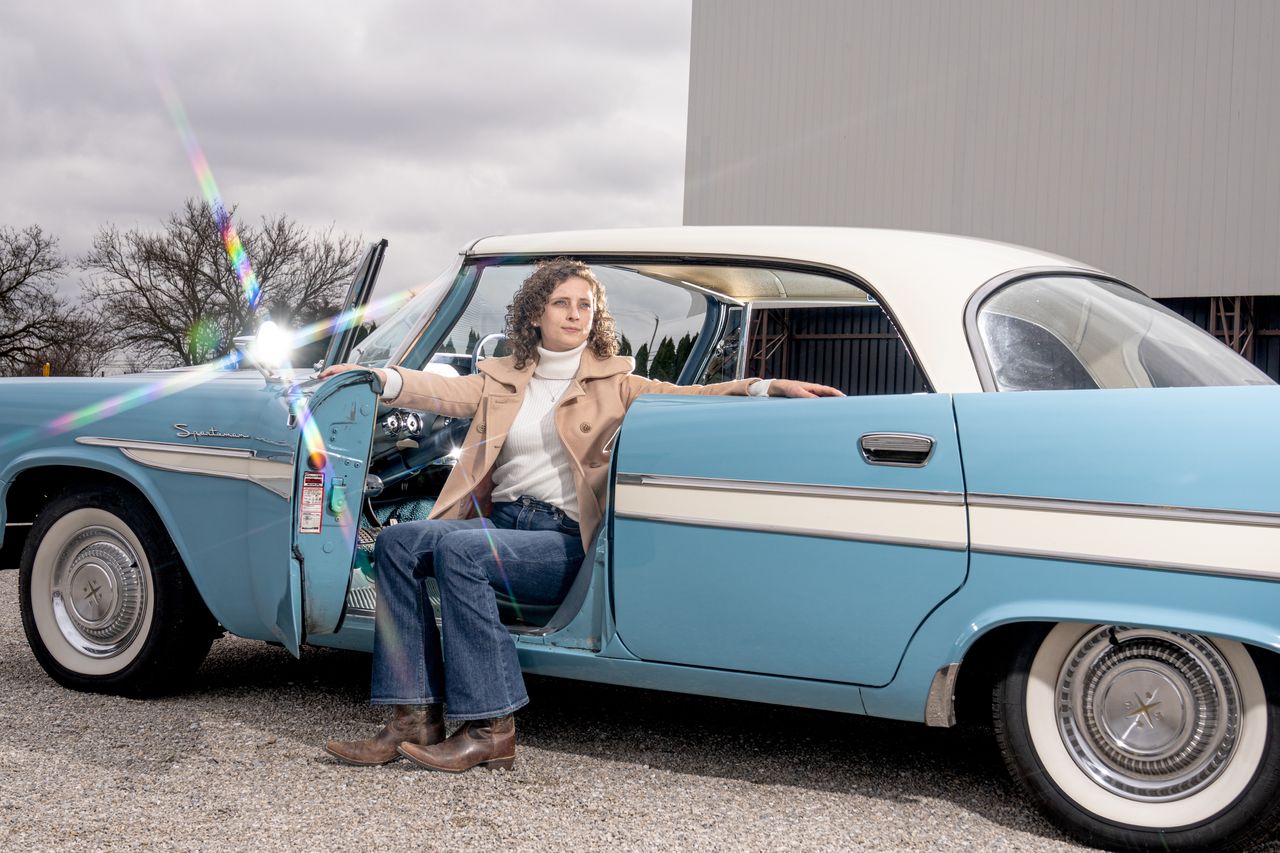Chrome, Sweet Chrome: The 1958 Classic That Won Her Heart
Christina Park fixed up her DeSoto Firesweep Sportsman after finding it at an estate sale
Christina Park, 24, a genetic counselling assistant at a children’s hospital who lives in Columbus, Ohio, on her 1958 DeSoto Firesweep Sportsman, as told to A.J. Baime.
My father started his company dealing in classic car parts when he was about 15, so since I was born, I have been around it. He was always rotating cars, new ones coming all the time. When I was 11 or 12, a DeSoto showed up on a trailer. I was just getting to the age where I was noticing cars, and what I liked and didn’t like. I liked fins, chrome and pretty colours. This DeSoto was all of that. I fell in love with it instantly, and, ever since, DeSotos have been close to my heart.
Most people, even up to my parents’ age, don’t know what DeSoto is, since DeSoto ended production in model year 1961. DeSoto was its own make of cars under the Chrysler umbrella, just like Dodge and Plymouth.
One weekend in 2016, my dad asked me if I wanted to go to an estate sale, which was a pretty common thing. When we got there, we found this DeSoto Firesweep Sportsman in the back of a garage, and it was for sale. Not too many people were there, and it was clear that no one had tried to start this car in many years. The colours were beautiful, and the car was similar to the DeSoto I had fallen in love with years earlier.
The Firesweep ended up coming home with us. I was 16, and, from the start, my dad said he would teach me what I needed to know to get it running and take care of it myself. But also, that it would be my car to do with what I wanted. When we started working on it, we were not sure how it was going to go. It needed a lot of TLC. We went through the usual mechanics. When we took off all the original belts and hoses, they cracked in our hands like pretzels. We put new tires on and polished the chrome. A year after we brought it home, it started right up.
It wasn’t my daily driver, but I started driving the DeSoto and, occasionally, taking it to school. Even people who were not car fans thought it was cool because of the paint and the chrome, and how different the styling was from anything you saw at the time. People were a little astonished by it.
Now, I have three DeSotos, but two of them are project cars that are not roadworthy. The Firesweep Sportsman gets stored through the Midwestern winters. But this time of year, I begin getting it ready for summer. I drive it to car shows and anywhere I can. Last summer, I put 1,600 miles on it. It is almost always the only DeSoto at a car show, so getting to show it off and talk about the brand is very rewarding.
I joined the National DeSoto Club even before I owned a DeSoto, and for the past two years, I have taken my car to the national conventions. It is a great community. A lot of the members are older, but there are younger people, and it’s so great to hang out with people who share this passion. The community is also very helpful if you have to find a rare part or need help doing something mechanically.
At the first national convention I went to, in 2022, I met the club’s magazine editor, David Frank. We started meeting up at other car events, and now we are two years into our relationship. He has a 1959 DeSoto Fireflite and, while he lives in Wisconsin and I live in Ohio, twice we have had our cars together. I guess I have gotten more than I ever could have expected out of my love for DeSoto.
 Copyright 2020, Dow Jones & Company, Inc. All Rights Reserved Worldwide. LEARN MORE
Copyright 2020, Dow Jones & Company, Inc. All Rights Reserved Worldwide. LEARN MORE
This stylish family home combines a classic palette and finishes with a flexible floorplan
Just 55 minutes from Sydney, make this your creative getaway located in the majestic Hawkesbury region.
As Paris makes its final preparations for the Olympic games, its residents are busy with their own—packing their suitcases, confirming their reservations, and getting out of town.
Worried about the hordes of crowds and overall chaos the Olympics could bring, Parisians are fleeing the city in droves and inundating resort cities around the country. Hotels and holiday rentals in some of France’s most popular vacation destinations—from the French Riviera in the south to the beaches of Normandy in the north—say they are expecting massive crowds this year in advance of the Olympics. The games will run from July 26-Aug. 1.
“It’s already a major holiday season for us, and beyond that, we have the Olympics,” says Stéphane Personeni, general manager of the Lily of the Valley hotel in Saint Tropez. “People began booking early this year.”
Personeni’s hotel typically has no issues filling its rooms each summer—by May of each year, the luxury hotel typically finds itself completely booked out for the months of July and August. But this year, the 53-room hotel began filling up for summer reservations in February.
“We told our regular guests that everything—hotels, apartments, villas—are going to be hard to find this summer,” Personeni says. His neighbours around Saint Tropez say they’re similarly booked up.
As of March, the online marketplace Gens de Confiance (“Trusted People”), saw a 50% increase in reservations from Parisians seeking vacation rentals outside the capital during the Olympics.
Already, August is a popular vacation time for the French. With a minimum of five weeks of vacation mandated by law, many decide to take the entire month off, renting out villas in beachside destinations for longer periods.
But beyond the typical August travel, the Olympics are having a real impact, says Bertille Marchal, a spokesperson for Gens de Confiance.
“We’ve seen nearly three times more reservations for the dates of the Olympics than the following two weeks,” Marchal says. “The increase is definitely linked to the Olympic Games.”

Getty Images
According to the site, the most sought-out vacation destinations are Morbihan and Loire-Atlantique, a seaside region in the northwest; le Var, a coastal area within the southeast of France along the Côte d’Azur; and the island of Corsica in the Mediterranean.
Meanwhile, the Olympics haven’t necessarily been a boon to foreign tourism in the country. Many tourists who might have otherwise come to France are avoiding it this year in favour of other European capitals. In Paris, demand for stays at high-end hotels has collapsed, with bookings down 50% in July compared to last year, according to UMIH Prestige, which represents hotels charging at least €800 ($865) a night for rooms.
Earlier this year, high-end restaurants and concierges said the Olympics might even be an opportunity to score a hard-get-seat at the city’s fine dining.
In the Occitanie region in southwest France, the overall number of reservations this summer hasn’t changed much from last year, says Vincent Gare, president of the regional tourism committee there.
“But looking further at the numbers, we do see an increase in the clientele coming from the Paris region,” Gare told Le Figaro, noting that the increase in reservations has fallen directly on the dates of the Olympic games.
Michel Barré, a retiree living in Paris’s Le Marais neighbourhood, is one of those opting for the beach rather than the opening ceremony. In January, he booked a stay in Normandy for two weeks.
“Even though it’s a major European capital, Paris is still a small city—it’s a massive effort to host all of these events,” Barré says. “The Olympics are going to be a mess.”
More than anything, he just wants some calm after an event-filled summer in Paris, which just before the Olympics experienced the drama of a snap election called by Macron.
“It’s been a hectic summer here,” he says.

AFP via Getty Images
Parisians—Barré included—feel that the city, by over-catering to its tourists, is driving out many residents.
Parts of the Seine—usually one of the most popular summertime hangout spots —have been closed off for weeks as the city installs bleachers and Olympics signage. In certain neighbourhoods, residents will need to scan a QR code with police to access their own apartments. And from the Olympics to Sept. 8, Paris is nearly doubling the price of transit tickets from €2.15 to €4 per ride.
The city’s clear willingness to capitalise on its tourists has motivated some residents to do the same. In March, the number of active Airbnb listings in Paris reached an all-time high as hosts rushed to list their apartments. Listings grew 40% from the same time last year, according to the company.
With their regular clients taking off, Parisian restaurants and merchants are complaining that business is down.
“Are there any Parisians left in Paris?” Alaine Fontaine, president of the restaurant industry association, told the radio station Franceinfo on Sunday. “For the last three weeks, there haven’t been any here.”
Still, for all the talk of those leaving, there are plenty who have decided to stick around.
Jay Swanson, an American expat and YouTuber, can’t imagine leaving during the Olympics—he secured his tickets to see ping pong and volleyball last year. He’s also less concerned about the crowds and road closures than others, having just put together a series of videos explaining how to navigate Paris during the games.
“It’s been 100 years since the Games came to Paris; when else will we get a chance to host the world like this?” Swanson says. “So many Parisians are leaving and tourism is down, so not only will it be quiet but the only people left will be here for a party.”
This stylish family home combines a classic palette and finishes with a flexible floorplan
Just 55 minutes from Sydney, make this your creative getaway located in the majestic Hawkesbury region.






















